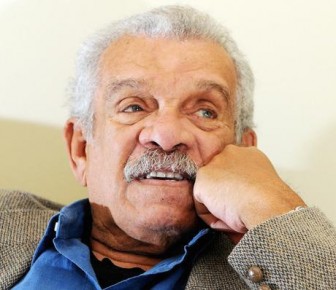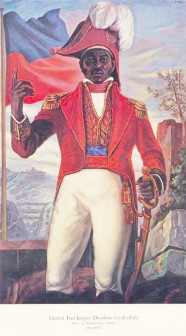His victory over a first class field in the 2010 TS Eliot Poetry Prize last month elevated Derek Walcott yet higher in world literature and placed him yet again under the international spotlight. It is not a position with which Walcott is unfamiliar, since this highly decorated artist is recognized as the best poet writing in English today. But the reputation he has earned is disproportionately biased towards his poetry with insufficient notice taken of his drama.
 Walcott is, of course, known as both a dramatist and a poet, although he started public life as a water colour painter, has done paintings and drawings all his life and has turned much more to painting in the last decade. The importance of his paintings, however, is largely owed to his fame as a writer, while his drama is a major part of Caribbean literature and theatre.
Walcott is, of course, known as both a dramatist and a poet, although he started public life as a water colour painter, has done paintings and drawings all his life and has turned much more to painting in the last decade. The importance of his paintings, however, is largely owed to his fame as a writer, while his drama is a major part of Caribbean literature and theatre.
His studies on the stage have developed alongside his explorations in verse, very often covering the same thematic ground and preoccupations. His rise to the pinnacle as the region’s foremost playwright came soon after his ascendancy in poetry. His development began with what critic Sam Asein calls his “Jamaica Years,” through the decade of the 1950s when he first began to pursue heroism in West Indian history, the St Lucian peasantry and the Classics.
This was followed by nearly 18 years as Artistic Director of the Trinidad Theatre Workshop during which his most significant development took place.
His early interest in heroes and heroism produced Henri Christophe (1954) and Drums and Colours (1960) while heroism was linked somewhat with the peasantry in Malcochon (1957), developing into Ti Jean and His Brothers (1967, but reportedly first crafted in 1958). By the late 1960s he had begun to study those along with colonialism and race. Going further, Walcott developed those interests while responding to the rise of Black Power and the 1970 uprising in Trinidad which produced his most outstanding play up to that point Dream on Monkey Mountain (1970) and In A Fine Castle (1971) re-worked as The Last Carnival (1983).

It is a rich heritage of Caribbean theatre which includes outstanding musicals; Ti Jean and His Brothers being one with the music of Andre Tanker and as he moved closer to Broadway, he had a long partnership with Galt McDermot, producing The Joker of Seville (1974). But he was not yet done with early excursions into history and heroism which developed significantly into Haytian Earth, while experiments with the Classics and Greek myths which started with Ione (1957) progressed into one of his greatest achievements The Odyssey (1991).
Walcott’s theatre has continued to be of major significance and has had prominent performances on stage right into the first decade of the twenty first century. There was a revival of Haytian Earth at the auditorium that was to become a part of the UWI Open Campus during the celebrations of the 200th Anniversary of the Haitian Revolution at UWI St Augustine in January 2004. This was one of the most outstanding productions of the decade, despite the controversy that it generated in Trinidad over Walcott’s interpretation of the history and his treatment of Dessalines. The self-crowned Emperor who was the one to declare the former French colony of Saint Domingue the independent state of Haiti, was studied as the first in a line of despots who raped Haiti. Central to this presentation is the leading character Yette, a former prostitute whose clients were Europeans.

Late in the drama she is raped by the brutal Emperor Dessalines in an interestingly crafted presentation in which Yette became a symbol of Haiti itself, the land, the “Haitian Earth.” She was made a prostitute under the Europeans and after independence she is violated by one Emperor and executed by the other, Henri Christophe.
Under the Haitian rulers, the rape of Haiti continues as the new monarchs replace the old and continue their plunder of peasantry, land and country.
Although this interpretation offended a section of the audience in Trinidad, it was not too far removed from the study of the same Haitian Revolution by the great Trinidadian CLR James in his play The Black Jacobins (1936 with several revivals). James’s Dessalines is also a rough, uncouth, corrupt revolutionary with political ambitions, who selfishly betrayed his leader, Toussaint L’Ouverture.
However, James gives him redeeming features, leaving the audience to judge just how much his behaviour was justified.
Dessalines was humanized and civilized to an extent by his love for Marie Jeanne, an equivalent of Yette in this play. He was illiterate and sought education and tutorship in the finer arts from his lover, whom he later married and made his Empress.
In James’s analysis the question is raised about whether Toussaint, who took the revolution to its success but hesitated at the point of actually breaking from France, would have really declared independence. Was Dessalines, therefore, not the right man to finally end colonial rule?
But James ends the play on a burning ironic note. This same revolutionary who took the decisive step, was an imitator, a eurocentric mimic in love with not only power, but the trappings of Europe.
However, putting controversy aside, Haytian Earth in 2004 was typical Walcott theatre of improvised illusion, using image and dance in theatre in the round in a fittingly creative auditorium.
It stood out among plays performed in the Caribbean in the 5 year period between 2004 and 2009.
Another of those most outstanding productions happened to be also a Walcott drama, Pantomime, a production of Dramaworks and the Cave Hill Theatre Workshop performed in Barbados and Trinidad.
It was directed by Robert Leyshon, lecturer in the Department of Language, Literature and Linguistics at UWI, Cave Hill.









